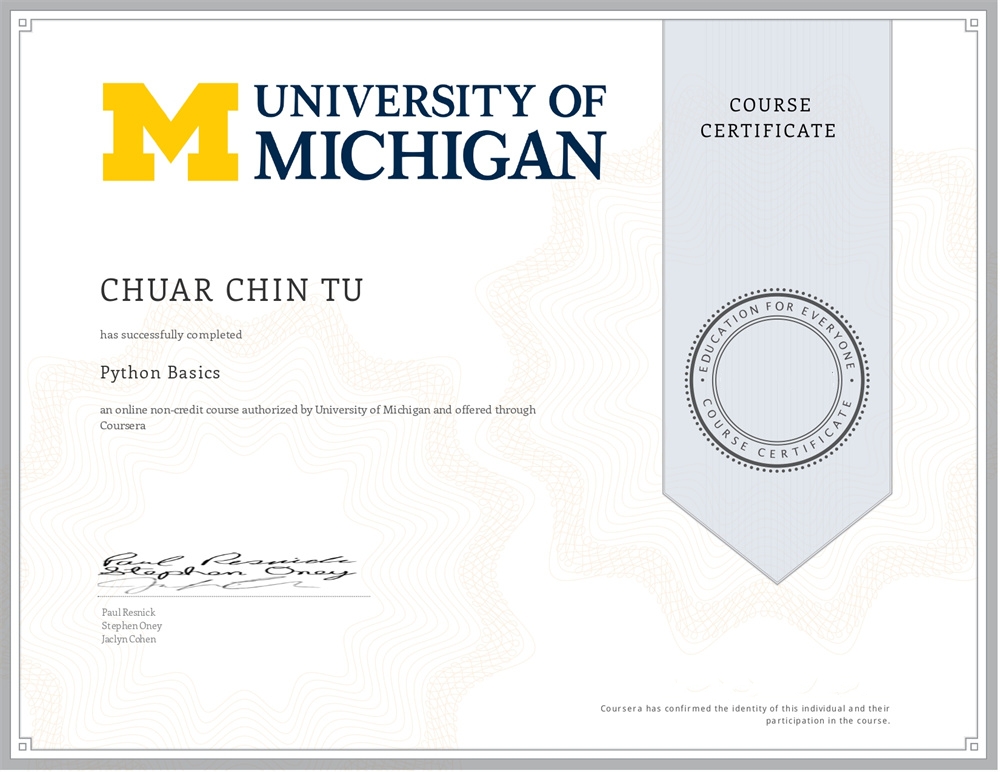Eric Chuar has completed the Python Basics for Personal & Professional Productivity and received a certificate from University of Michigan.
SCHOOL:
University of Michigan
GRADUATED:
2018
DURATION:
6 Months

Python Basics Skills Gained
Use active code and multiple choice questions in textbook Describe the purpose of programming languages Distinguish between formal and natural languages Explain the use of comments
Simulate evaluation of an expression Distinguish between expressions, values, and printed representations Identify the following types of values: strings, integers, floats, functions Recognize valid vs. invalid variable names; write an assignment statement; simulate evaluation of an assignment statement and update a reference diagram.
Recognize and explain hard coding Write a multi-line program (using the turtle framework) Invoke methods and set attributes using dot notation Distinguish instances, attributes, and methods Distinguish between syntax, runtime, and semantic errors
Learn Python 3 basics, including conditional statements, loops, and data structures like strings and lists. Develop practical programming skills by creating drawings and building your debugging abilities.
Course Perspective
Just finished up the “Python Basics” course and, honestly, it’s like I’ve been given a new set of tools. I’ve always been a hands-on guy—why wait for a course when you can dive in headfirst, right? Certificates are fine and all, but nothing beats the experience of actually doing the thing.
Purpose of Programming Languages: The course kicked off with the basics, explaining why we even need programming languages. I mean, I’ve always known they’re essential for my digital marketing and programming work, but understanding the “why” puts a whole new spin on things.
Formal vs Natural Languages: This part was intriguing. We dug into the differences between formal languages like Python and natural languages like English. The precision required in formal languages made me realize how much room for error there is in everyday communication. Definitely something I’ll consider when crafting marketing messages.
Comments and Code: I learned the importance of comments in code. It’s like leaving a trail of breadcrumbs for anyone who reads your code. A small thing, but it goes a long way in team settings.
Expressions and Values: We then moved on to expressions and values, distinguishing between the two, and even got into types like strings, integers, and floats. These are the building blocks of any program, and understanding them deeply can only make me better at what I do.
Hard Coding and Syntax: Hard coding is a no-no, but understanding why it’s frowned upon was enlightening. We also delved into multi-line programming and touched upon common errors—syntax, runtime, and semantic—that one can encounter.
Python 3 Fundamentals: The course ended with Python 3 essentials, including loops and data structures. And yes, I even got to draw some shapes using Python’s turtle framework!
So what’s next? Well, I’m not keeping all this knowledge to myself. Whether it’s in digital marketing, programming, or any of my other passions like badminton and red wine, I’m sharing what I know. Life’s too short to keep things to yourself, especially when you’ve got a family and a kiddo to think about. Time to spread some Python knowledge in Malaysia and Singapore, my home away from home. Let’s do this!
